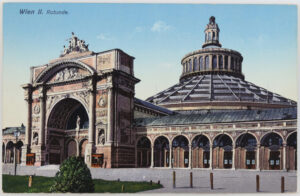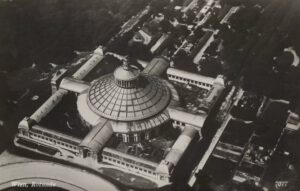
In 1801, the Irishman Robert Barker, who also founded panorama painting in 1788 with the world’s first circular painting, opened the first panorama rotunda on the European continent in the Vienna Prater. Rotundas were round buildings with spectacles for the masses inside. The largest domed building in the world at the time was the legendary World’s Fair Rotunda of 1873, which served as the centerpiece of the most important building, the Palace of Industry, and amazed visitors with its dimensions: Both St. Paul’s Cathedral and St. Peter’s Basilica would have fit inside the 84-metre-high domed structure made of wood and steel with a diameter of 108 meters and an area of around 8,000 square meters.

The Scottish naval architect John Scott Russell provided the initial plans, and the project was realized with modified designs under the direction of the architect Carl von Hasenauer and in cooperation with Johann Caspar Harkort V, a member of the Duisburg steel dynasty Harkort. Inside, there was a viewing gallery and a four-meter-high stone replica of the imperial crown. Four halls connected the building and the galleries. The main portal was designed as a triumphal arch, decorated with semi-columns and figures. “Viribus Unitis” – “with united forces” – the motto of Emperor Franz Joseph was emblazoned under the gable. The earth excavated during the construction of the rotunda still forms the Constantine Hill on the main avenue. This was named after Lord Chamberlain Prince Konstantin von Hohenlohe-Schillingsfürst.
Although the pompous rotunda in the Prater was originally only intended for this event, the mixed end of the World Exhibition did not leave enough money for its demolition, which is why it continued to be used as a multi-purpose event location for more than 60 years: in 1883 for the Electrical Exhibition, in 1892 for the International Music and Theater Exhibition and in 1898 for the Imperial Jubilee Trade Exhibition. Other event highlights included the performance of the tightrope walker Blondin, the “Hero of Niagara” (1879), the premiere of the famous “Fiakerlied” by Gustav Pick, sung by Alexander Girardi (1885) or the grandiose spring festival of Princess Pauline Metternich for the benefit of the rescue society (1887). Another absolute highlight was the stopover by the world’s most famous circus, Barnum & Bailey, which graced the Rotunda in 1900.
However, the rotunda, known by the Viennese as the “Guglhupf”, only became a landmark after the catastrophe of September 17, 1937, when the partially clad steel construction burned to the ground – especially the interior cladding made of wood and plaster and the wallpaper made of printed jute proved to be welcome fodder for the flames. The World Exhibition Rotunda is still present in Vienna today: the Rotunda Bridge, Rotunda Avenue, Rotunda Square and the “Rotunda” stop on the Lilliputbahn are all reminders of the legendary magnificent building. And with our PANORAMA VIENNA, we are also reviving the tradition of the Rotunda in the Vienna Prater – as a modern interpretation of a visual and emotional spectacle for the 21st century.

